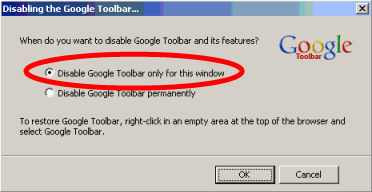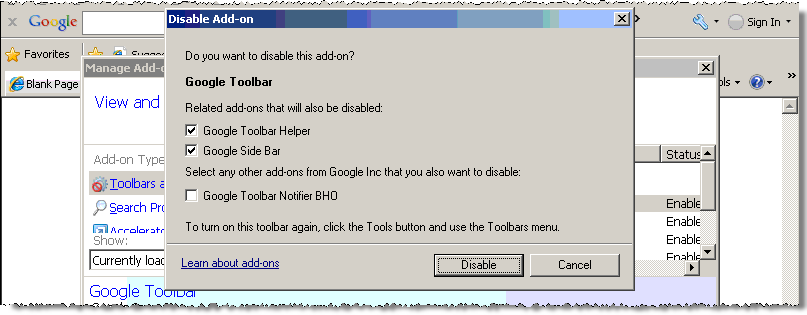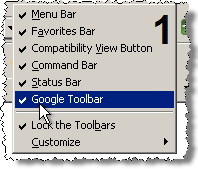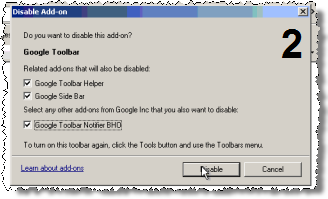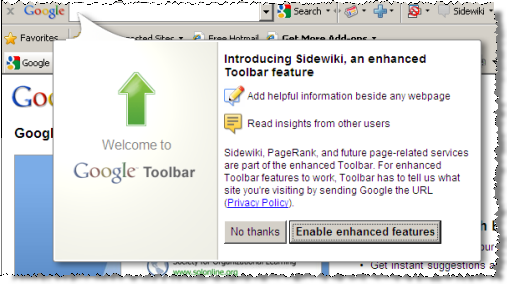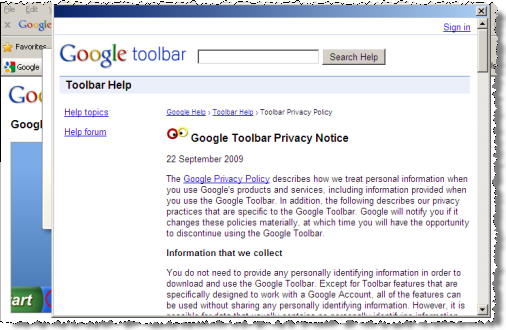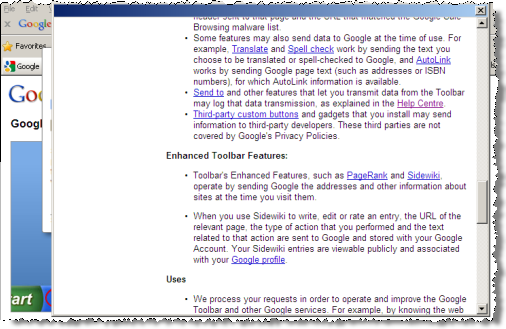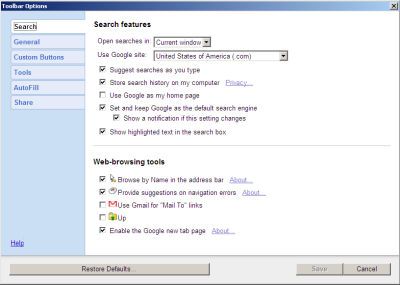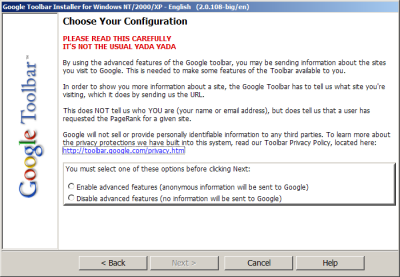Disclosure: I serve as co-counsel in unrelated litigation against Google, Vulcan Golf et al. v. Google et al. I also serve as a consultant to various companies that compete with Google. But I write on my own — not at the suggestion or request of any client, without approval or payment from any client.
In one of the few areas of Internet advertising where Google is not dominant – where just three years ago Google had no offering at all – Google now uses tying to climb towards a position of dominance. In particular, using its control over web search, Google offers preferred search ad placement and superior search ad terms to the advertisers who agree to use Google Affiliate Network. Competing affiliate networks cannot match these benefits, and Google’s bundling strategy threatens to grant Google a position of power in yet another online advertising market.
Google shows algorithmic search results at the left side of users’ screens, while Google’s "AdWords" ads appear at the right and, often, top. Historically, Google has sold search ads on a cost-per-click basis: An advertiser is charged each time a user clicks its ad. With these offerings, Google has grown to a position of dominance in search and in search advertising — 77% share of U.S. web search in the US, with even higher levels in other countries.
While Google dominates online search, Google to date has made less headway in the area of affiliate marketing, an approach to online advertising wherein small to midsized sites ("affiliates") receive payments paid if users click links and make purchases from the corresponding merchants. For example, Gap pays a 2% to 4% commission if a user clicks an affiliate link to Gap and goes on to make a purchase. While almost all of the web’s largest merchants run affiliate programs, as of the start of 2007 Google offered no affiliate marketing services. Only through its mid-2007 acquisition of DoubleClick did Google obtain an affiliate marketing program, then called Performics and now renamed Google Affiliate Network (GAN). But Google’s affiliate network began in third place in the US market — behind larger competitors Commission Junction and LinkShare.
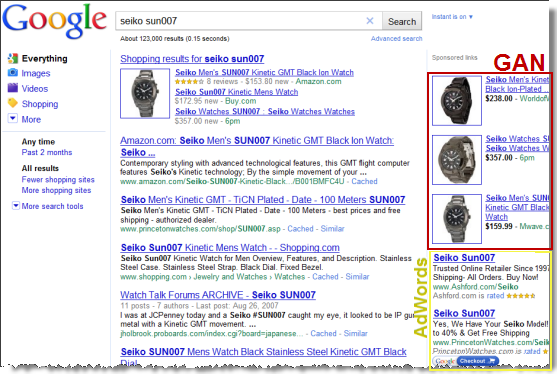 Beginning in November 2009, Google’s Product Listing Ads service gave GAN major advantages over competing affiliate networks. Within search ads, Google now includes listings not just to Google’s AdWords pay-per-click advertisers, but also to GAN advertisers. Through these placements, Google offers GAN advertisers four striking and valuable benefits:
Beginning in November 2009, Google’s Product Listing Ads service gave GAN major advantages over competing affiliate networks. Within search ads, Google now includes listings not just to Google’s AdWords pay-per-click advertisers, but also to GAN advertisers. Through these placements, Google offers GAN advertisers four striking and valuable benefits:
- Image ads. AdWords advertisements show only text. But GAN advertisements include an image — making GAN offers stand out in search results. See the three image ads highlighted in red in the screenshot at right.
- Preferred placement. AdWords advertisements are ordered, Google says, based on how much each advertiser bids as well as Google’s assessment of ad relevance, click-through rate, and other factors known only to Google. But in my testing, all GAN ads appear at the top of the "right rail" of side listings — prominent, highly visible screen space that gets more attention than any AdWords listings below. Indeed, by pushing AdWords ads further down the page, GAN ads reduce the value of the AdWords slots. In the screenshot at right, notice that all three GAN image ads appear above all the right-rail AdWords ads.
- Conversion-contingent payment. AdWords advertisers continue to pay on a per-click basis, incurring costs as soon as a user clicks a link. In contrast, GAN advertisers only have to pay if a user clicks a link and purchases a product.
- Preferred payment terms. Because AdWords advertisers pay as soon as a user clicks, they must pay for users’ clicks even if servers malfunction, even if credit card processors reject users’ charges, and even if users return their orders or initiate chargebacks. In contrast, in all these circumstances, GAN advertisers incur no advertising costs at all.
I expect Google will argue that it is within its rights to package, bundle, and tie its products as it sees fit. I disagree. Here, Google ties its search offering to its affiliate network without an apparent pro-competitive purpose but with obvious anti-competitive effects. In particular, tying affiliate network services to preferred search ad format and placement gives GAN an advantage over competing affiliate networks, without efficiencies or other countervailing benefits to users or advertisers.
Furthermore, there is no plausible justification for providing image ads only to GAN advertisers or for granting all GAN ads positions above all right-side AdWords ads. To the contrary, Google could easily allow all AdWords ads to include images, and Google could instead intersperse GAN ads (and ads from other affiliate networks) among AdWords advertisements in whatever order auctions and algorithms fairly deem optimal. Those would be the natural product design decisions if Google genuinely sought to include images wherever useful and if Google genuinely sought to include affiliate ads whenever relevant. Because Google instead reserves these benefits for GAN advertisers, the natural inference is that Google reserves special rewards for advertisers choosing GAN — benefits that come at the expense of genuine competition in affiliate marketing services.
In the remainder of this piece, I discuss why the public should be concerned about Google’s tying tactics, then assess Google’s tying-based promotion of its various other products. I conclude with brief policy prescriptions.
I see four major reasons for concern in Google’s decision to tie GAN to preferred placements, format, and terms in sponsored search.
First, GAN’s tying threatens to extend Google’s dominance into yet another facet of online advertising. Google’s dominance in search and search advertising is well-known. But affiliate marketing is a rare area where, until recently, Google had little or no presence. By leveraging its dominance in search to take over yet another type of online advertising, Google will importantly limit advertisers’ options. Today, advertisers unhappy with Google’s AdWords prices or rules can consider working with independent web sites through affiliate programs not operated by Google. But if Google comes to dominate affiliate marketing, then even affiliate marketing will become unavailable to advertisers dissatisfied with Google. Indeed, knowing that it dominates multiple aspects of online advertising, Google will be in a position to raise prices that much further.
Second, GAN’s tying harms those AdWords advertisers who refuse GAN and buy only pay-per-click ads from Google. The more GAN ads Google puts above ordinary AdWords listings, the less visible AdWords advertisers become. AdWords advertisers are at a further disadvantage when Google gives image ads to GAN advertisers but not AdWords advertisers, and when Google offers preferred terms (e.g. refunds of advertising costs if a user returns a product) to GAN advertisers but not AdWords advertisers. Google promises that "the highest ranked ad is displayed in the most prominent position," but when Google gives GAN ads the top positions, ordinary AdWords advertisers are left bidding on the leftovers. And as Google makes its left-side listings increasingly visual — inline maps, images, product pictures, video thumbnails, and more — advertisers need images to capture users’ attention. So AdWords-only advertisers, without image-based ads, end up at a significant disadvantage.
Third, for nearly a year Google has offered the Product Listing Ads benefits in "limited beta" available only to "a small number of participants" Google selects. In fact I’ve seen numerous advertisers, large and small, promoted in Product Listing Ads. But it is striking to see Google offer preferred listings only to those advertisers Google chooses to favor. Elsewhere Google argues that its auction-based ad sales are "equitable." But when Google gives superior placement to its preferred advertisers, for nearly a year, Google’s rules seem the opposite of fair.
Finally, GAN’s tying is particularly worrisome in the context of other Google tactics. As detailed in the next section, Google uses and has used bundling and tying to enter and dominate numerous markets. If these tactics continue unchecked, we face a future where Google’s dominance stretches even further.
Google’s Tying Strategy More Broadly
Tying GAN to search is just one example of Google’s oft-repeated tactic of forcing customers who want one Google service to accept additional Google services too. This section presents a series of such examples.
Throughout, these tying examples fit the following form:
A [user type] who wants [desirable Google service] must also accept [unwanted Google service].
I now turn to specifics.
Tying to promote affiliate marketing services: An advertiser who wants top placement in Google search advertisements, image ads, and preferred payment terms must join Google Affiliate Network.
Details: See above.
Tying to promote low-quality syndicated search marketing services: An advertiser who wants placement through high-quality Google Search Network sites must also accept low-quality Google Search Network placements.
Details: Google’s Search Network includes some top-quality publishers such as AOL Search and New York Times. But if an advertiser contracts to advertise through Google Search Network, Google demands permission to also place the advertiser’s ads on whatever other sites Google selects, in whatever quantity Google chooses. Many of these placements are low-quality or worthless, including spyware popups, typosquatting sites, and deceptive toolbars. Many of these placements trick advertisers into believing they are receiving valuable traffic when in fact the traffic consists of users the advertisers had already reached or would receive anyway. Even if an advertiser learns about these problems, the advertiser must continue to pay for this traffic, on pain of losing access to Google’s high-quality search partners.
Tying to promote vertical search: A user who wants Google’s core algorithmic search results must also accept Google’s own vertical search results.
Details: Users relish Google’s highly-regarded algorithmic search results. But a user running search at Google also receives Google’s vertical search services: Whether the user prefers Bing Maps, Google Maps, Mapquest, or Yahoo Maps, Google Search always presents inline maps from Google, and so too for images, local businesses, products, scholarly articles, videos, and more. On one view, these vertical search services are an integral part of Google’s offering, but scores of competing vendors reflect a competing vision of users choosing core algorithmic search separately from vertical search services. By granting its special-purpose search services preferred placement, Google sharply reduces traffic to competing vertical search services.
Tying to promote ancillary mobile services : A mobile phone developer who wants Google’s Android certification and access to Android Market application store must also accept Google’s ancillary services, including geolocation.
Details: In a September 2010 complaint, Skyhook alleges that Google ordered Motorola not to ship a proposed device that would have included both Google Location Service and Skyhook’s XPS service, two distinct methods to determine a user’s geographic location. Skyhook claims that Google grounded its threat in Google’s Android Market application store: If Motorola shipped a device with software Google did not approve, Google would ban users of that device from accessing Android Market or running the apps available there. By requiring that Motorola omit Skyhook’s service in order to give users access to Google Market, Google denied users access to Skyhook.
Advertisers, consumers, policy-makers and the concerned public should give tying relationships a careful look. In principle, bundling previously-separate offerings can offer useful synergies and efficiencies. But bundling can also let a company expand from strength in one area into dominating numerous additional fields — limiting choice, raising prices, and reducing innovation.
In some instances, it may not be obvious how to separate bundled products. For example, there is currently no single clear mechanism whereby Google search results could embed maps, product feeds, or other structured or interactive information from other search services. Pending a compelling plan to unbundle vertical results from core search, my instinct is to save this problem for later — albeit perhaps requiring disclosure of favored treatment Google gives its own search services, or limiting the permissible extent of such favored treatment.
In other instances, market structure and product design yield a natural vision of products that could be separate, generally are separate, and should rightly remain separate. To my eye, these principles ring particularly true in the separation between search marketing and affiliate marketing. There is no logical reason why GAN advertisers should enjoy the only listings with images. Nor is there any logical reason why all GAN ads should appear above all right-side AdWords ads. When Google grants its GAN advertisers these special benefits, the best conclusion is that Google is using its dominance in search to establish dominance in affiliate marketing — seizing an unearned advantage over competing affiliate marketing services. These exclusionary tactics are unjustified and improper, and they ought not be permitted.
Google’s first step should be to cease tying Google Affiliate Network to preferred search placement, format, and terms: An advertiser seeking to include image ads should not have to sign up with GAN, nor should GAN ads arbitrarily appear above competitors. A recent post at Channel Dollars off-handedly reports that Product Listing Ads "has been taken out" GAN and "is being merged into" AdWords. That’s a fair start. But even temporary ties can impede competition, and Google has delivered these large benefits only to GAN advertisers for some ten months.
Meanwhile, Google’s preferred treatment of selected GAN advertisers foreshadows a worrisome future. If Google can give preferred treatment to advertisers who use GAN, what prevents preferred treatment of advertisers who support Google’s regulatory agenda, and inferior treatment of advertisers who complain to policy-makers? Indeed, I doubt that Google invited to Product Listing Ads any advertisers who have publicly criticized Google’s practices. Google’s ability to distribute valuable but opaque favors to preferred advertisers — and to withhold such favors from anyone Google dislikes — makes Google’s power that much stronger and, to my eye, that much more troubling.
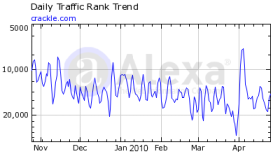 Three years ago, I posted
Three years ago, I posted 
